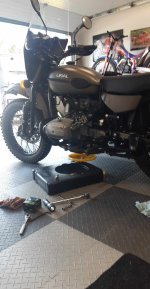Removing the top plate and leaving the uprights in place would be convenient if you want to grab the whole thing and take it into the hotel with you without fumbling with unstrapping the bag, but might not be worth the effort.That is version 2, or the deluxe upgraded model.
Personally, I'd probably just glue the top plate in place as previously suggested. It already looks really good. A simpler tool-free sorta-quick-detach method would be to just replace the 4 bolts in the uprights with hand knob bolts, although they are ridiculously expensive for what they are.
















